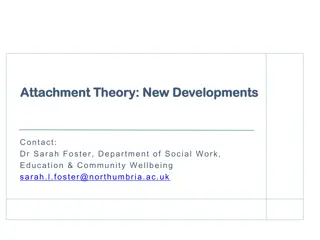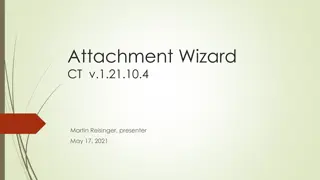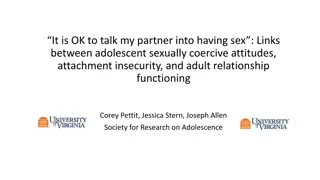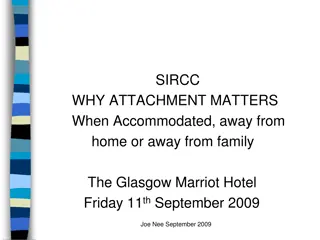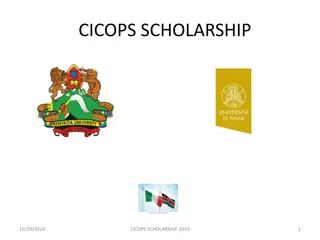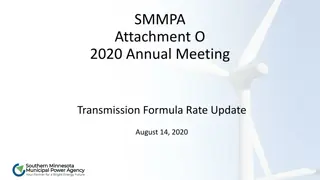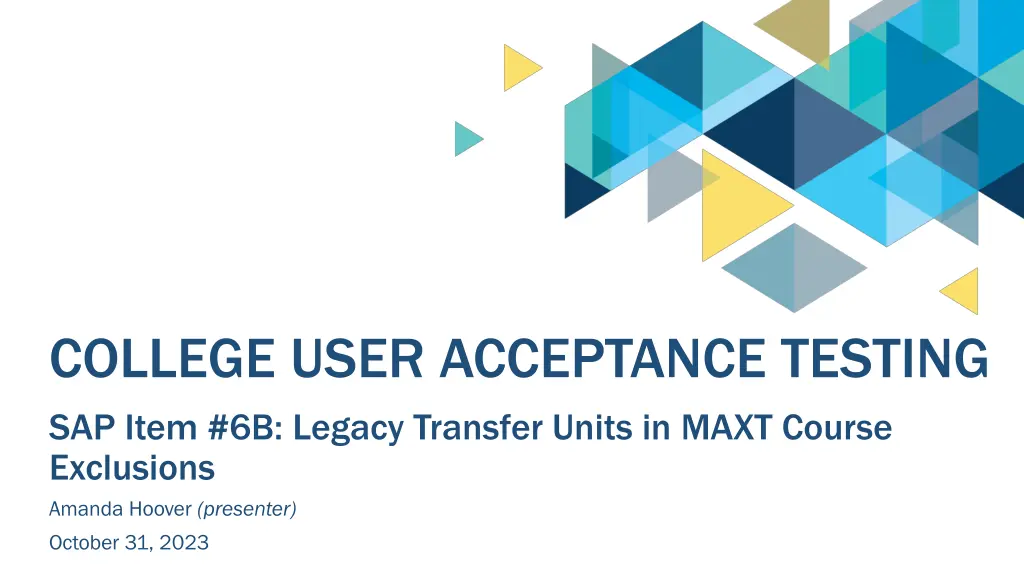
Legacy Transfer Units Solution in SAP Implementation
Implementing a custom solution in SAP to accurately calculate legacy transfer units in the Maximum Attempted Units Test, resolving issues with manual entry and exclusion of remedial units. The project overview, solution design, and implementation timeline are detailed for the College User Acceptance Testing phase.
Download Presentation

Please find below an Image/Link to download the presentation.
The content on the website is provided AS IS for your information and personal use only. It may not be sold, licensed, or shared on other websites without obtaining consent from the author. If you encounter any issues during the download, it is possible that the publisher has removed the file from their server.
You are allowed to download the files provided on this website for personal or commercial use, subject to the condition that they are used lawfully. All files are the property of their respective owners.
The content on the website is provided AS IS for your information and personal use only. It may not be sold, licensed, or shared on other websites without obtaining consent from the author.
E N D
Presentation Transcript
COLLEGE USER ACCEPTANCE TESTING SAP Item #6B: Legacy Transfer Units in MAXT Course Exclusions Amanda Hoover (presenter) October 31, 2023
AGENDA Project Overview of SAP Item #6B Legacy Transfer Units in MAXT Course Exclusions A note about the updated Solution Design Document Delivered Maximum Attempted Units Test functionality Solution Design User Acceptance Testing Next Steps 2
PROJECT OVERVIEW SAP Item #6B: Legacy Transfer Units in Maximum Attempted Units (MAXT) Course Exclusions 3
IMPLEMENTATION TIMELINE College User Acceptance Testing Oct 31 to Nov 13 College Testing Sign Off Nov 13, end of day Targeted Production Release Date Nov 28 4
SAP ITEM #6B: LEGACY TRANSFER UNITS IN MAXT COURSE EXCLUSIONS Problem Statement Problem Statement If a student returns to a college and has previous enrollment records that were not captured in the conversion to ctcLink, the legacy data manually entered as Transfer Units is not calculated correctly in the Maximum Attempted Units Test (MAXT). Remedial units entered manually are not being excluded from the MAXT evaluation (up to the Max Remedial Units to Exclude value set by colleges) under Course Exclusions in their SAP configurations. Solution Solution Create a custom view to identify legacy units and corresponding course information added manually in ctcLink. Clone the delivered PeopleSoft Financial Aid SAP Application Engine (AE) for the Maximum Attempted Units Test. Modify the copied code to compare the custom view against additional delivered enrollment tables to pull the data points necessary to compare these legacy transfer units to the Course Exclusions configuration. Update the SAP AE Process Setup configuration page for each institution to point to the custom code. 5
SOLUTION DESIGN DOCUMENT UPDATES Language clarifications All terminology referring to the calculation outcome from the Maximum Attempted Units have been updated to Maximum Attempted Units value to provide more clarity on the intent of this customization work. Title updated to specify that only legacy units on the transfer credit table are impacted by this customization. Regular transfer units will follow delivered functionality. Updated version is available on the SAP Project Information guide on the ctcLink Reference Center. 6
MAXIMUM ATTEMPTED UNITS TEST Delivered SAP Functionality Impacted 7
MAXIMUM ATTEMPTED UNITS TEST Calculates the attempted units prior to the term being evaluated Rules allow colleges to specify at what point a student fails this test Complemented by Course Exclusions SAP configuration Allows colleges to specify courses that should not count toward Maximum Attempted Units value Allows colleges to specify a maximum number of units that can be excluded from the Maximum Attempted Units value Two Course Types: Remedial and ESL Course Exclusions do not apply to any other SAP Test or calculation 8
MAXIMUM ATTEMPTED UNITS TEST SETUP Checkbox to enable SAP process to use this test Types of transfer/other units to be included in the Maximum Attempted Units value calculation Range of Maximum Attempted Units this test will apply to SAP Status to be assigned if student meets these criteria 9 Navigation: Set Up SACR > Product Related > Financial Aid > Satisfactory Academic Progress > Define Set Up Criteria >> Criteria 1 tab
COURSE EXCLUSIONS SETUP Checkbox to enable SAP process to use this configuration (works with the Maximum Attempted Units Test only) Maximum number of units that can be excluded from the total Maximum Attempted Units value, based on Course Type in the configuration below. (Blank means no limit.) Course Type options (Remedial or ESL). These correspond to the Max Units to Exclude configurations. List of Courses to be excluded from the total Maximum Attempted Units value and categorized by Course Type 10 Navigation: Set Up SACR > Product Related > Financial Aid > Satisfactory Academic Progress > Define Set Up Criteria >> Exclusions tab
MAXIMUM ATTEMPTED UNITS STUDENT SAP PAGE Displays the total Maximum Attempted Units value up to the term being evaluated Course Exclusions apply to this value, per local configurations Displays information in the Rule Range fields if the student matches a Max Attempted Units Rule 11 Navigation: Financial Aid > Satisfactory Academic Progress > Maintain Student SAP Data
MAXIMUM ATTEMPTED UNITS VALUE CALCULATION Unit totals from Student Term History (STDNT_CAR_TERM) Student Enrollment data (STDNT_ENRL) compared to the Course Exclusions configurations Attempted ESL Units to Exclude* Attempted Remedial Units to Exclude* Maximum Attempted Units Attempted Units Transfer Units** *These values are subject to the Max Units to Exclude values in setup **All items checked in the Maximum Attempted Transfer Unit Criteria configuration are considered by the SAP test as part of the Transfer Units value calculated here (Towards GPA, No GPA, Course Credit, Test Credit, Other Credit, and TC Units Adjust). 12
THE PROBLEM SAP Item #6B: Legacy Transfer Units in MAXT Course Exclusions 13
THE PROBLEM Non-converted legacy data is manually entered by the college as transfer credit This legacy data is not stored in the student s enrollment record MAXT is designed to exclude courses on the enrollment record MAXT does not exclude courses entered in as transfer credit Legacy courses at the college are not excluded from the final Maximum Attempted Units value, per local college configuration Students may inaccurately fail the Maximum Attempted Units Test 14
THE PROBLEM STUDENT EXAMPLE This student has 8 units of remedial courses manually entered from legacy that should be excluded from the Maximum Attempted Units value. 15
THE PROBLEM STUDENT EXAMPLE The Maximum Attempted Units value is unaffected by the Course Exclusions logic, as the only courses to exclude for this student are manually entered legacy units. 8 legacy remedial units should be excluded Student has failed the MAXT Test 16
THE SOLUTION SAP Item #6B: Legacy Transfer Units in MAXT Course Exclusions 17
CUSTOMIZED CALCULATION OF MAXIMUM ATTEMPTED UNITS VALUE Add logic to include a custom view to identify and evaluate non-converted, manually entered legacy transfer units against Course Exclusions Attempted ESL Units to Exclude* Attempted Remedial Units to Exclude* Maximum Attempted Units Attempted Units Transfer Units Legacy Remedial Units to Exclude (Transfer) Remedial Units to Exclude (Enrollment) Legacy ESL Units to Exclude (Transfer) ESL Units to Exclude (Enrollment) *Note: These values are still subject to the Max Units to Exclude values in setup 18
SOLUTION STUDENT EXAMPLE BEFORE AFTER 8 legacy remedial units removed Student now meets MAXT 19
USER ACCEPTANCE TESTING Testing Timeframe: October 31 to November 13 October 31 to November 13 Testing Sign-off Due: November 13, end of day November 13, end of day 20
TESTING SCOPE In Scope In Scope Maximum Attempted Units Test Students with non-converted, manually entered legacy units for courses listed in the local college Course Exclusions configuration Out of Scope Out of Scope Other SAP Tests Students with converted legacy units these are already being excluded as desired per the local college Course Exclusions configuration 21
OVERVIEW OF TESTING STEPS 1. Review Maximum Attempted Units Test setup for your college 2. Review Course Exclusions setup for your college 3. Define test scenarios 4. Run query to find test students 5. Run query for information on manually entered legacy data 6. Compare legacy units to Course Exclusions 7. Process SAP a. Manually build SAP for test student b. Run SAP in batch or Report Mode 22
STEP 1 - REVIEW MAXIMUM ATTEMPTED UNITS TEST SETUP Review Maximum Attempted Transfer Unit Criteria We recommend that all boxes are checked Review Max Attempted Units Rules Review Attempted MAX Units From and Attempted MAX Units To ranges Ensure there are no overlapping ranges for each Academic Program/Academic Plan combination 23
STEP 1 - REVIEW MAXIMUM ATTEMPTED UNITS TEST SETUP We recommend that all of these boxes are checked. If not, then some types of transfer units will not be included in the Maximum Attempted Units calculation Ensure there are no overlapping From/To ranges for each Academic Program/Academic Plan combination 24 Navigation: Set Up SACR > Product Related > Financial Aid > Satisfactory Academic Progress > Define Set Up Criteria >> Criteria 1 tab
STEP 2 - REVIEW COURSE EXCLUSIONS SETUP Review Max Units to Exclude Max ESL Units to Exclude Max ESL Units to Exclude Most colleges leave this value blank, meaning any courses with a Course Type of ESL will be excluded. Max Remedial Units to Exclude Max Remedial Units to Exclude Most colleges set this to 45, meaning that all courses with a Course Type of Remedial will be excluded up to a total of 45 units. Any beyond that number will be included in the Maximum Attempted Units value. Review Course Exclusions list Most colleges do not currently have courses coded as ESL in ctcLink, likely due to previous functionality issues addressed by the SAP #3 MAXT bug fix project. We have identified ESL courses that were already in your college s Course Exclusions list and changed them to the ESL Course Type to support UAT testing. We will not make these changes in the production environment. 25
STEP 2 - REVIEW COURSE EXCLUSIONS SETUP Export the list of courses to exclude to an Excel sheet to review courses and identify any that need to be added or adjusted Confirm the Max Units to Exclude values these apply to both the legacy units and the student s enrollment data in ctcLink 26 Navigation: Set Up SACR > Product Related > Financial Aid > Satisfactory Academic Progress > Define Set Up Criteria >> Exclusions tab
STEP 3 DEFINE TEST SCENARIOS Suggestions: Student with only enrolled courses to exclude Student with only legacy courses to exclude Student with both enrolled and legacy courses to exclude Student with no courses to exclude Student with ESL or Remedial or both Course Types to exclude Student who has exceeded the Max Remedial Units to Exclude value Student with Career Exceptions 27
OTHER QUESTIONS TO CONSIDER Do your college s configurations align with your college s posted SAP policy? Does this customization align with your college s SAP policy? Does this customization present new scenarios that need to be accounted for? Think of students that are often manually adjusted after SAP has been run can they be resolved with this customization? 28
STEP 4 RUN QUERY TO FIND TEST STUDENTS Testing Query: QCS_FA_TEST_SAP6B_STDNTS Selects students who have failed the Maximum Attempted Units test and have manually entered legacy units that likely could be excluded SAP Term calculated Source term for SAP calculation This query is for testing only, and will not be migrated to the production environment 29 Navigation: Reporting Tools > Query > Query Viewer
STEP 5 RUN QUERY FOR LEGACY UNITS INFORMATION Testing Query: QCS_FA_TEST_SAP6B_LEGACYDATA Selects manually entered legacy units on the transfer credit table prior to the SAP term being calculated SAP Term calculated Key information for determining how many legacy units should be excluded from the Maximum Attempted Units value Test student ID This query is for testing only, and will not be migrated to the production environment 30 Navigation: Reporting Tools > Query > Query Viewer
STEP 6 COMPARE LEGACY UNITS TO COURSE EXCLUSIONS CONFIGURATIONS Export the list of Courses Exclusion to an Excel sheet for looking up courses Take note of Max Units to Exclude values these apply to both the legacy units and the student s enrollment data in ctcLink 31 Navigation: Set Up SACR > Product Related > Financial Aid > Satisfactory Academic Progress > Define Set Up Criteria >> Exclusions tab
STEP 7A CALCULATE SAP PER STUDENT QRG - https://ctclinkreferencecenter.ctclink.us/m/92428/l/926757-9-2-calculating-sap-per-student Note Maximum Attempted Units value Set SAP Term and select Calculate button Confirm Maximum Attempted Units value has updated to the expected amount If the Maximum Attempted Units value isn t as expected Double check the legacy units for any other courses that might be on the Course Exclusions list Check to see if the ESL/Remedial Max Units to Exclude has been exceeded by other courses the student has attempted that are not legacy units 32 Navigation: Financial Aid > Satisfactory Academic Progress > Maintain Student SAP Data
STEP 7B PROCESS SAP IN BATCH QRG - https://ctclinkreferencecenter.ctclink.us/m/92428/l/939595-9-2-process-sap-in-batch Be sure this box is unchecked. For testing, we want the batch SAP Process to update students whose Maximum Attempted Units Tests have already been processed previously to see the outcome in a batch situation with the customization in place. Review SAP results and ensure that other SAP tests and business processes for your college are not impacted by this customization Confirm no errors in Process Monitor Spot-check SAP report for anything that looks out of the ordinary Be sure to select this option, as Maximum Attempted Units values may be updated by the customization, but still not have an impact on the final SAP Status outcome. Navigation: Financial Aid > Satisfactory Academic Progress > Process SAP 33
ASKING QUESTIONS & REPORTING ISSUES Trouble Logging In? Email Caitlin Stein cstein@sbctc.edu Questions? Email Amanda Hoover ahoover@sbctc.edu CC Ana Ybarra aybarra@sbctc.edu Found Issues/Errors? Submit a ticket to Service Desk https://servicedesk.sbctc.edu/ Request Type: ctcLink Support > Testing ctcLink Support > Testing Subject: UAT UAT FA SAP Legacy Data in MAXT FA SAP Legacy Data in MAXT [description of issue] of issue] Include screenshots, IDs used, and detailed steps taken UAT FA SAP Legacy Data in MAXT [description] [description 34
TESTING ENVIRONMENT AND LOGIN INFORMATION PQA Test Environment: https://pt-pqa.peoplesoft-nonprod- aws.ctclink.sbctc.edu/psp/ptpqa/?cmd=login Environment Availability: Monday to Friday, 7am to 7pm Environment Last Refreshed: 10/19/2023 Logging In: Username = Your EMPLID Password = [testers check email after this session] 35
SIGN-OFF Survey Monkey link: https://www.surveymonkey.com/r/WKMPWG6 One response per college Complete by end of day on November 13th 36
TESTING RESOURCES UAT Testing Materials page https://ctclinkreferencecenter.ctclink.us/m/98421/l/1722924-sap-item-6b- transfer-units-in-maxt-course-exclusions More detailed information than in this slide deck Additional resources linked on the page 37
NEXT STEPS SAP Item #6B: Legacy Transfer Units in MAXT Course Exclusions 38
NEXT STEPS Follow-up Communications Slide deck and recording link to ctcLinkFinAidSupport and DirFinAid eLists Email to testers with their passwords and sign off survey link User Acceptance Testing October 31 to November 13 Sign Off Due end of day November 13 Implementation (if approved by testing colleges) Target: November 28, 2023 Target: November 28, 2023 Email announcement to ctcLinkFinAidSupport and DirFinAid eLists SAP Information Guide updates https://ctclinkreferencecenter.ctclink.us/m/PMO_Info/l/1625563-fa- satisfactory-academic-progress-sap-project-information-guide 39
THANK YOU FOR TESTING! Except where otherwise noted, this work is licensed under CC BY 4.0.


